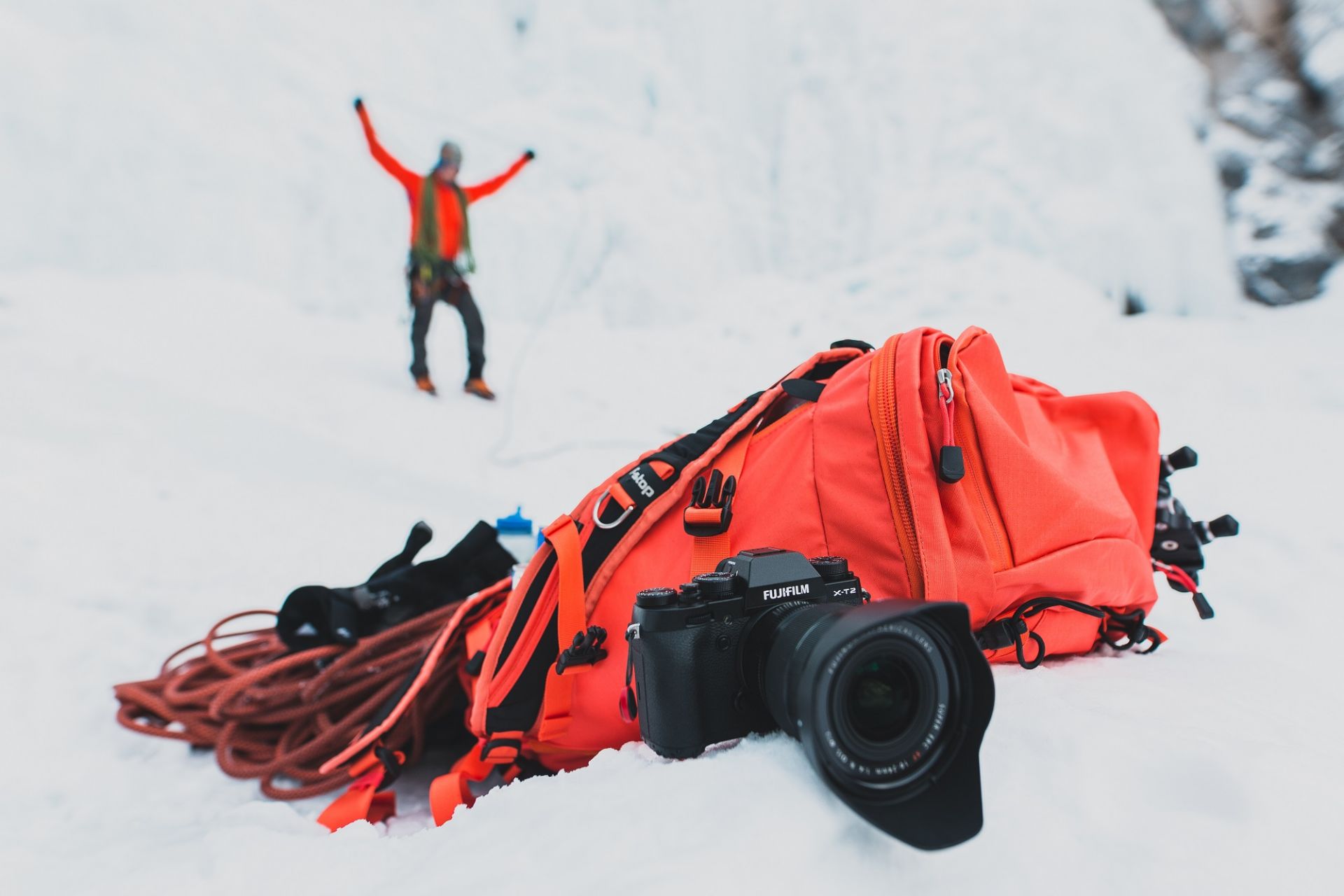
f-stop customer Tyler Weber is a photographer and educator based in Alberta, Canada with a passion for landscape photography. As a lover of the outdoors, his photography and his passion for climbing take him to beautiful locations in search of dramatic landscapes and epic light. Join Tyler as he explores the Jasper national park, navigating the rhythms of adventure through a day of ice cimbing and landscape shooting in the Canadian Rockies.
Words and photos by Tyler Weber


During the initial phase of planning a trip I always have to consider the balance of walking away with compelling images as well as the climbing aspirations set out by the group. Being able to keep pace with a rhythm that finds me shooting landscapes during the early hours of the mornings’ calm stillness and then quickly transitioning to the chaos of climbing is always a challenge.
Being that Jasper National Park is in my backyard, I am lucky enough to be able to plan where the light will fall based on my past experiences. Sitting alone in the calmness of the morning with the ancient Rocky Mountains towering overhead is a feeling I will never be able to fully explain. There is a sense of reverence that washes over me as I try my best to capture these amazing giants. I sit and wait for the light to come, anticipating, considering drama within composition and allowing my creative subconscious to take over. As the golden light becomes a bluebird day, I head back to the truck, feeling both happy with the morning outing and excited for the afternoon of ice climbing in the canyon.


We decide to try and find some good ice at a local spot, the beautifully sculpted Maligne Canyon, where the climbing is laid back but always full of adventure. As we meander our way up the ancient canyon, we test the ice, crawl under massive log jams, and eventually find a beautiful pitch of ice to climb. It always amazes me the contrast in the style of shooting that comes with going from landscapes to adventure photography; with landscapes you set up and enjoy the light but with something like climbing the camera always has to be at the ready because you never really know what the changing environment will demand. I felt very pleased with the images that came from the moments between the climbing, mostly because they tell the story of the adventure to get to the ice and it’s these moments - the in between adventures - that truly made this day memorable.
Hiking out of the canyon that day, I reflected on how it really never is about the climbing - it’s about getting out and adventuring. Whether we climb hard routes or just meander our way up a frozen canyon, my soul is happy taking pictures of both - whatever the day unfolds to be.
As the light fades from the day, my last objective of the trip was to get to Sunwapta Falls, a hotspot for any photographer passing through the Canadian Rockies. We head in the exact opposite direction of the canyon we just climbed and prepare to change gears once again - leaving the chaos behind and returning again to the calm of capturing a landscape. Sunwapta Falls demanded a fresh perspective, so upon my arrival, I set out to capture their beauty in a new an unseen way. I set up for this unique shot, calculating, planning for the best use of fading light and I click the shutter. I am happy I chose this new perspective, because I ended up with a new portfolio image I am really proud of. I love that when people see the image they have to take a second glance to realize it’s the famous Sunwapta Falls. The last rays of light descend behind the great Rockies and I am left with a heart full of gratitude to have gotten out and done what I love all in the span of one day. The images are what we get out for, but truthfully, it is the soul medicine we seek of a good day out.

You may find more of Tyler's work on his web site, Facebook and Instagram.
"We Are f-stop" is for all f-stop users to share their stories from the field, from small daily adventures to epic travels. Contact us with your story on Facebook or drop us an email to [email protected] and let us know where your photography takes you and your f-stop pack!
SHOP ALL GEAR MORE WE ARE f-stop


©2022 F-stop
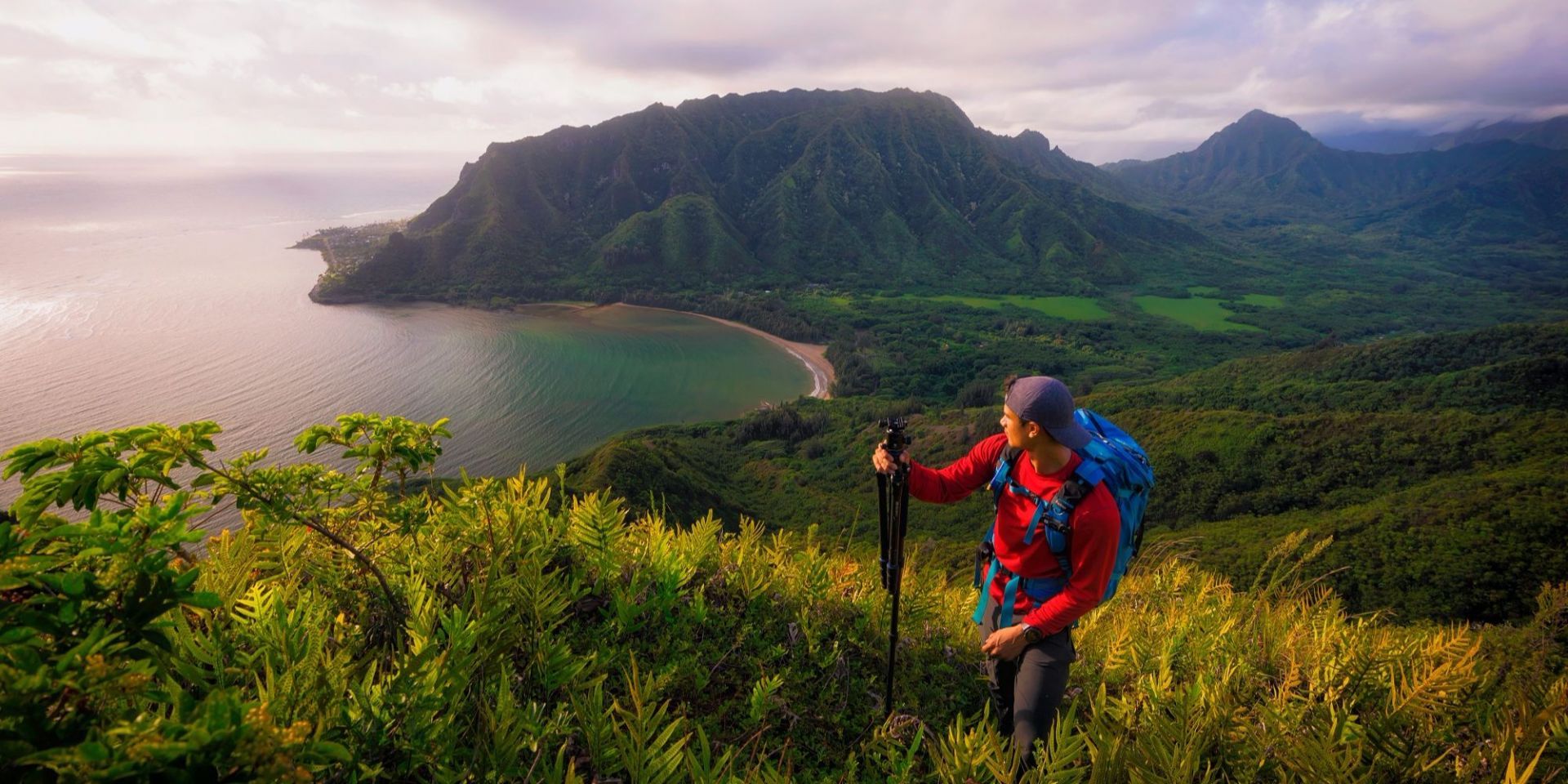
We are often in awe at the amazing locations our customers take their f-stop packs to fulfill their creative visions, and this 'We Are f-stop' story is no exception! Born and raised in Waialua, Hawai‘i, Kawika Lopez starts his days well before the sun comes up. He hikes up O‘ahu’s highest ridges and deep into its lush valleys, striving to find the most unique perspectives through the lens. In his words:
“I do the things that most people aren’t willing to do in order to achieve something that most people will never achieve,"
As a full-time filmmaker and photographer, Kawika considers himself extremely blessed top have a career doing something he loves He found his passion for photography and video in high school, later pursuing a degree in creative media. Today, Kawika is a partner at 9th Avenue Studios and owns his own photography company called Kawika Lopez Photography.
Words and photos by Kawika Lopez:

Three and a half hours before sunrise, Lopez wakes up to his alarm. He lays down his F-Stop Gear backpack on the ground and start to load his gear. Trying to keep his pack light, he leaves most of his camera gear behind and packs just his Sony a7R III, two lenses, and a tripod. This leaves him plenty of room for other hiking essentials. When he is feeling extra ambitious heʻll even stuff a whole Phantom 4 Pro drone in there.

As Kawika hits the road, the eastern sky is still draped in darkness. Hopefully he can get to the trailhead before the horizon starts to glow. As he arrives at his destination, Lopez says a quick prayer for protection and safety before strapping on his gear and hitting the trail.
“I just want to get to the ridge before the clouds start to change color,” Kawika hopes as he charges up the steep paths.
Once he hits the ridge the world becomes a visual playground. Not many people are willing to start a hike in complete darkness, but for Kawika, to see the first light of day from atop the mountains of Hawai‘i is a treasure in and of itself.


It’s a significant amount of energy that Lopez puts into his craft, and he chooses his gear very carefully. Each piece of gear is hand-picked, from a lightweight camera system, to grippy hiking boots, and a rigged and secure backpack. Kawika knows that top-notch gear is not just about status or a brand. It’s about usability, build quality, and most important, safety.
Three to four times a week, Lopez trains at a rock climbing and bouldering gym. He considers the technical aptitude of rock climbing to be an extremely valuable and almost essential asset while he scales the towering peaks of the islands.

“Adventure photography is a very demanding genre. I always find myself in situations that most people would consider risky,” says the O‘ahu native. “I can’t emphasize enough the importance of knowing your terrain, your gear, and most importantly, yourself."

You may find more of Kawika's work on his web site, and Instagram.
"We Are f-stop" is for all f-stop users to share their stories from the field, from small daily adventures to epic travels. Contact us with your story on Facebook or drop us an email to [email protected] and let us know where your photography takes you and your f-stop pack!
SHOP ALL GEAR MORE WE ARE f-stop


©2022 F-stop
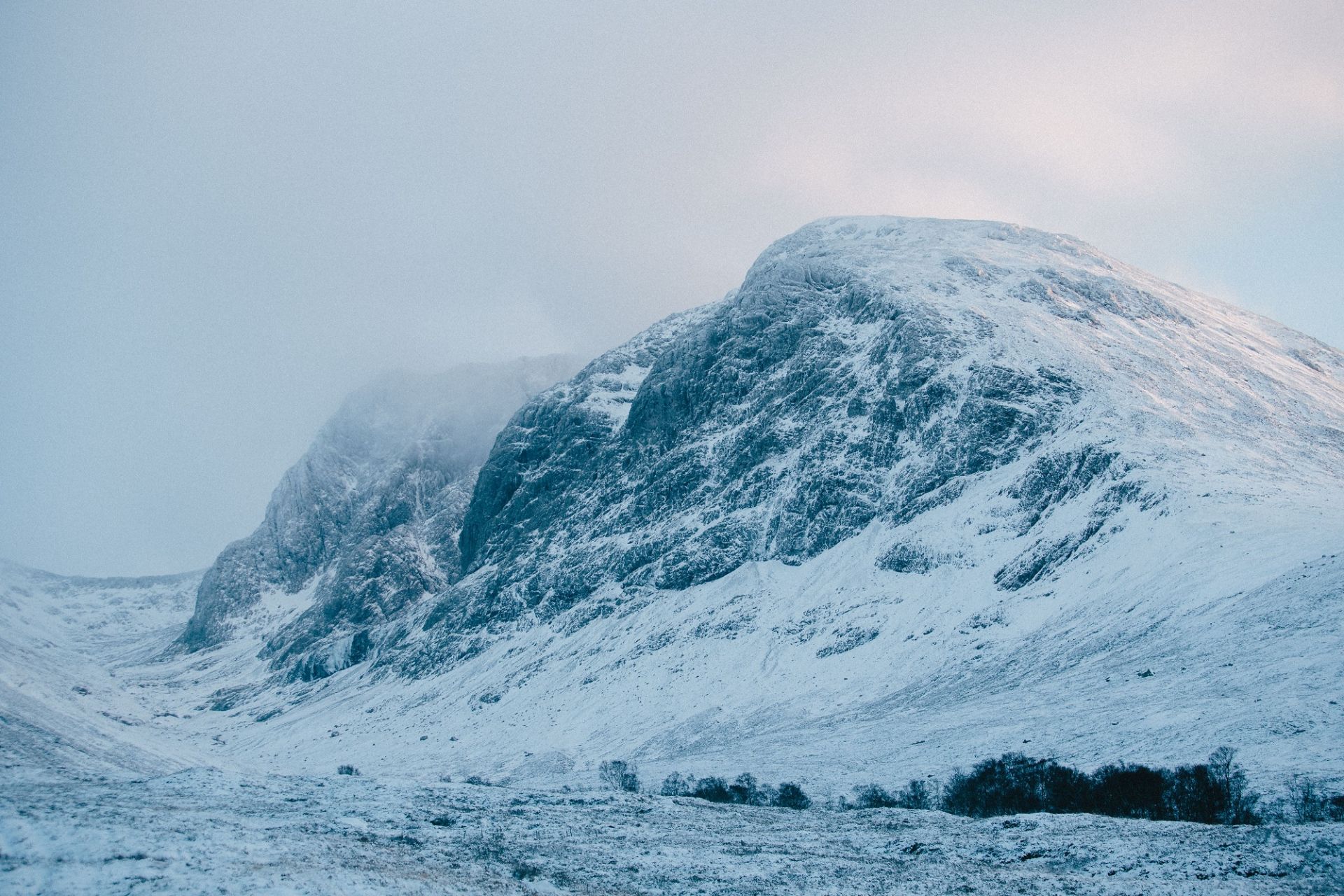
Olly Jelley is a freelance wildlife cameraman, working on television and film productions for some of the most respected companies, such as the BBC and National Geographic. You might think that would be enough to keep him busy, but in the time between those jobs this f-stop customer can’t sit still. Camera in hand, he loves any kind of adventure, and you’ll often find him battling through adverse weather conditions and exploring remote trails on foot or sometimes bike. He says that he is not much of a writer, and as cliché as it sounds, much prefers to tell his stories with a camera & lens. Luckily for us, Olly thought he’d give it a crack and share a bit of what goes on behind the lens on a shoot for Epic TV with the f-stop Shinn pack last winter...
Words and photos by Olly Jelley

It’s 4.30AM and after a solid week of early starts, long journeys and late nights, it’s time to haul my tired body off my sleeping mat once again. After a very mild week, it finally started snowing again last night, so we prayed today was the day the weather gods would deliver.
We’re in Fort William, deep in the highlands of Scotland, keeping an eagle eye on the North Face of the mighty Ben Nevis. Having just completed a mad few days doing a mid-winter camping & deep water solo climbing expedition out on the western isles, we’re now changing gear to head up into the mountains proper for a few days shooting some kit review & tutorial videos for Epic TV. The idea we had pitched was to take a look at winter in a different way from all the normal seasonal mountaineering media in the digital abyss, and have a look at what makes a Scottish winter different to an Alpine winter. Which by the way, is changeability, sleet, and short lived weather windows, which this mild weather was providing us with plenty of evidence of.

Today it turns out, is indeed the day. A peek out of the window into an orange streetlit garden shows a good few inches of snow, and it can only be better at altitude. Landrover loaded up we slither our way up tracks through the powder-silenced forest, passing the odd car abandoned at the bottom of steeper slopes from those who had been out on a night mission. Glad of a proper 4x4, we break clear of the tree line and park up to begin our hike, catching our first proper view of the north face hiding up the corrie. It’s still a good hour and a half until sunrise and the flat hint of pre-dawn light gives the blanket of snow the faintest blue hue of some seriously ‘in’ conditions. It was going to be a busy day up here soon with a town full of mountaineers who’d been itching all season to get anything resembling a proper day in, so it was time to saddle up and get going before the gold rush. Zeemon, our ‘fast and light’ Fort William resident & tech expert, questions my rucksack choice once more, “Can’t you just film it on a little camera and one lens?”. This has been a frequent topic of conversation leading up to the shoot, but the stubborn hiker/cameraman in me who is used to a life of hauling it decides the challenge worth it enough to wave him off. I’ll grant him now though, away from the mountain and my concerns having gauged the size of it for the first time, that indeed the Shinn is a big bag. Having said that, packing a filming kit, snow gear, and the 3 tons of Malt loaf required to survive a stop start day filming in such adverse and full on conditions needs some serious space.



For the tech nerds out there, I’m shooting with a Dslr for this project despite the video priority on it in an attempt to keep things light enough (and also because I’ve taken on role of shoot photographer). Body of choice is a Magic-Lantern hacked 5Dmk3 (the RAW video is astounding if you can be bothered and strict enough with the workflow) B-camera to Mike on a Canon C100ii who is doing our ‘sync’ work proper. I’ve got a 400mm lens and a doubler for those big compression shots to hopefully bring some proper scale in and make a double camera setup worthwhile. I also have a 70-200 & a 16-35 to cover my more general shooting when we’re filming ‘piece to camera’ sections, and for beauty shots of the kit we’re reviewing and using. A tripod too, for long lens & controlled beauty shots. A small speedlite head & profoto umbrella are stashed in as the light is incredibly unpredictable when shooting in low cloud and with so much reflection around from the snow you never know what you’re going to get. Aside from that, the aforementioned food, water & warm, waterproof snow gear is all in too with a pair of climbing axes strapped to the back for good measure. Like I said, big bag!
A post shared by f-stop Gear (@fstopgear) on Apr 13, 2017 at 8:52am PDT
Laced & layered up now, kit checked, and backs strapped tightly on, we get our heads down and make our way towards the CIC hut, a 45min hard hike to the real start of our day, where we turn west and look straight up the 2300ft cliffs of the North Face, our shoot location for the day.

You can follow more of Olly's work on his website, Instagram and Facebook.
"We Are f-stop" is for all f-stop users to share their stories from the field, from small daily adventures to epic travels. Contact us with your story on Facebook or drop us an email to [email protected] and let us know where your photography takes you and your f-stop pack!
SHOP ALL GEAR MORE WE ARE f-stop


©2022 F-stop

Sascha Tay is 21-year-old photographer and f-stop user from Germany, based in Norway. He specializes in photographing the colder parts of the world, and over the past three years he has managed to capture the landscapes of Iceland, most of Northern Norway, and the Faroe Islands, with their visually stunning scenery but often inhospitable shooting environments.
When going on these trips you never know what to expect, as the weather changes from minute to minute. You might get stuck in your accommodation for the whole trip and barely get to see out of your window due to the artic winds and snow storms in the winter. This is what makes the cold seasons in the north very unpredictable and photo missions so much more challenging than a nice warm location. However, it is the unpredictable weather and changing conditions that got him hooked on these locations, wanting to explore more and more of the remote places that not everyone has on the top of their list and fewer have seen in person. Sascha's goal is to tell the stories of these places, and show their unique beauty to a wider audience, so for this 'We Are f-stop' we'll hand over to him...
Words and photos by Sascha Tay


Coming from Hamburg in Germany and seeing the incredible Norwegian mountains that makes you feel so small standing in front of them was a humbling experience, and it made me want to try and capture that humbling feeling and share it though my images. From the tiny classic red Norwegian cabins to the small fishing boats in the Faroe Islands, and to the volcanic black sand beaches of Iceland against the massive glaciers just 200m from the shore.


When I first started to explore Norway as my entry to the photography journey of the cold northern countries, I was completely unprepared. Wearing a pair of sneakers and jeans might not have been the smartest decision, but it was an experience I needed to go through to move on to real hiking shoes, waterproof jacket from Helly Hansen and mountain pants from Fjellreven, but most importantly a real camera bag. I’ve gone though about 5-6 different bags, each amazing in their own way and for different situations, but I wanted and needed a bag that could survive the same extreme conditions I would experience.


From -24 Celsius and wind so strong it blew me over making it feel like -40 at times, to downpour and hail while hiking on the Faroe Island, located in the rough sea between the North and Norwegian sea with no shield from the winds of the ocean, to easy access to reach different gear while doing a plane ride over the Icelandic volcanoes, I needed a bag to fit all these circumstances. The Tilopa has kept my gear safe, dry and easy accessible. It has given me the peace of mind that the cameras and lenses would make it safely to my destination, while I had to focus on climbing a mountain or not being blown over off a cliff. Knowing my gear is safe I could concentrate on keeping myself safe as well, and it made it possible to capture these wild and beautiful places.


Find more of Sascha's work from northern landscapes on his Instagram profile.
"We Are f-stop" is for all f-stop users to share their stories from the field, from small daily adventures to epic travels. Contact us with your story on Facebook or drop us an email to [email protected] and let us know where your photography takes you and your f-stop pack!
SHOP ALL GEAR MORE WE ARE f-stop


©2022 F-stop
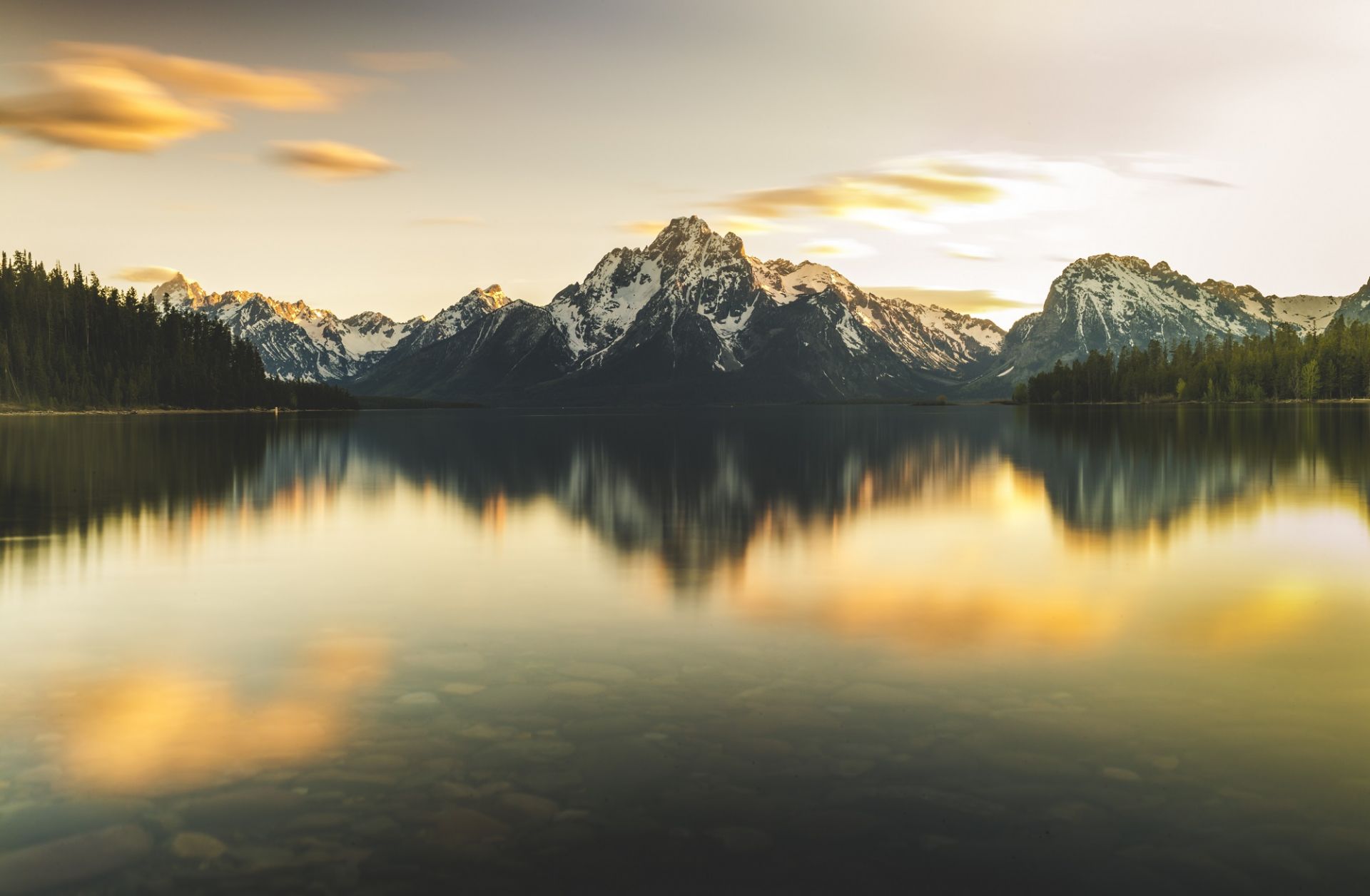
Customer Eric Hu is a 22-year-old adventure photographer and environmentalist. He loves to travel and in the last 3 years has travelled across 48 states documenting 43 or the USA's 59 National Parks. When he's not on the road shooting the stunning landscapes, he works as a strategist in the advertising industry for major brands. In this 'We Are f-stop' story, we hear how he took his skills from the advertising world and combined them with his passion for the great outdoors to create the SideWagon project.
Words and photos by Eric Hu

Tell us more about SideWagon. What is it and what was the inspiration for the project?
Entering the advertising industry, I was shocked by how little representation there was; for a field as creative as marketing, cultural diversity is crucial in the storytelling process. That’s why we created SideWagon, a student-run content studio working with agencies and brands alike to bring experiential content creation to life. As I like to say, we are inherently adventurous, naturally curious, and designed for collaboration.
The inspiration was twofold: one problem we’ve heard over and over is that students always ask, “how can I get a job if I don’t have experience, and how can I get experience if I don’t have a job?”. In 2016, National Geographic reported that 71% of millennials have never been to a National Park. That’s when I realized there was a solution for both problems.
Today, we are a collective of 30+ students across 5 universities donating our time towards bringing fellow millennials into public lands and providing brands our platform as nomadic creators a more authentic way of creating local relevance. Every time we embark on an adventure, we go on hikes or photowalks with resident artists to glean perspectives and stories that aren’t normally heard. This provides the students we bring actual portfolio-building work with amazing clients as well as life-changing cultural experiences on the road.


Do you plan on going abroad? Why have you focused so much on the National Parks?
The short answer is yes. I firmly believe that you can’t understand someone else’s culture until you understand your own. After the 2016 election, it became apparent that not only does the country we live in not listen to each other, it’s actually quite hard to hear what others have to say! I don’t for a second blame someone in middle of Montana for feeling left out from the coastal cities. That’s why I focus all of my efforts on taking urban millennials from LA, SF, Boston, Philly, NYC, and Miami into the heartland and actually see what life is like for the majority of the country.
America is beautiful and there is so much to cherish. I have been fortunate enough to see what makes this country special, and it’s a shame that so many feel it is inaccessible. And as the current administration looks to defund conservation efforts, its up to every day people like myself to push against that.
In 2016, the National Travel and Tourism board reported that more young Americans chose to travel abroad than spend time domestically. Until that changes, I will continue my efforts here.

Speaking of National parks, which is your favorite and why?
That’s an impossible question that I get asked daily. It really depends on how much time you have and where you live. I joke that it’s tough to find incredible beauty like Yosemite or Yellowstone east of the Rockies, but that actually isn’t true at all. I’ve gone to Acadia almost a dozen times, and it’s the first sunrise in America. Shenandoah’s Old Rag hike in Virginia is an accomplishment in its own right, and witnessing sunset in the Great Smokies, Tennessee left me speechless. I encourage people to instead ask, what is my favorite kind of park? Am I looking for an epic hike? Do I want breathtaking forestry? Pristine lakes? Monumental rock formations? Don’t ask me what my favorite park is, I challenge everyone to go find their own, because the more you visit, the more you will realize that it’s impossible to choose.

If you had any advice for students or other millennials looking to travel more, what would it be?
Just do it. There are so many resources out there that can help, and the best way to approach a passion project is to think about how you can monetize it. Something I like to do is look in the mirror in the morning when I wake up and ask, “what am I wearing or going to need today that someone else can pay for, or pay me to wear/use?” If you think about advertising, it’s all about finding the right media/medium to place your message. Often, the medium is the message. In my case, it happens to be that where I go, what I wear, what I use, and how I travel, that becomes the medium that gets monetized. And that is the most sustainable model of living that I have found for myself thus far.
So what’s next?
This Spring, from March 8 - 18th, I will be bringing 5 students from Los Angeles to Seattle, documenting Yosemite, Mt. Rainier, Olympic, and Los Padres National Parks/forests. We will be flying cross-country for under $300 round trip thanks to our sponsor SkyHi, and working with Hertz for transportation when we land. Thanks to Mountain Safety Research and ENO, we will be able to house all six of us in tents and hammocks while being fed by our partner, CLIF bar. As for clothing, special thanks to Groceries Apparel, MeUndies, and Arc’teryx for the apparel!
Follow Eric's journey on his Instagram channel.
"We Are f-stop" is for all f-stop users to share their stories from the field, from small daily adventures to epic travels. Contact us with your story on Facebook or drop us an email to [email protected] and let us know where your photography takes you and your f-stop pack!
SHOP ALL GEAR MORE WE ARE f-stop


©2022 F-stop
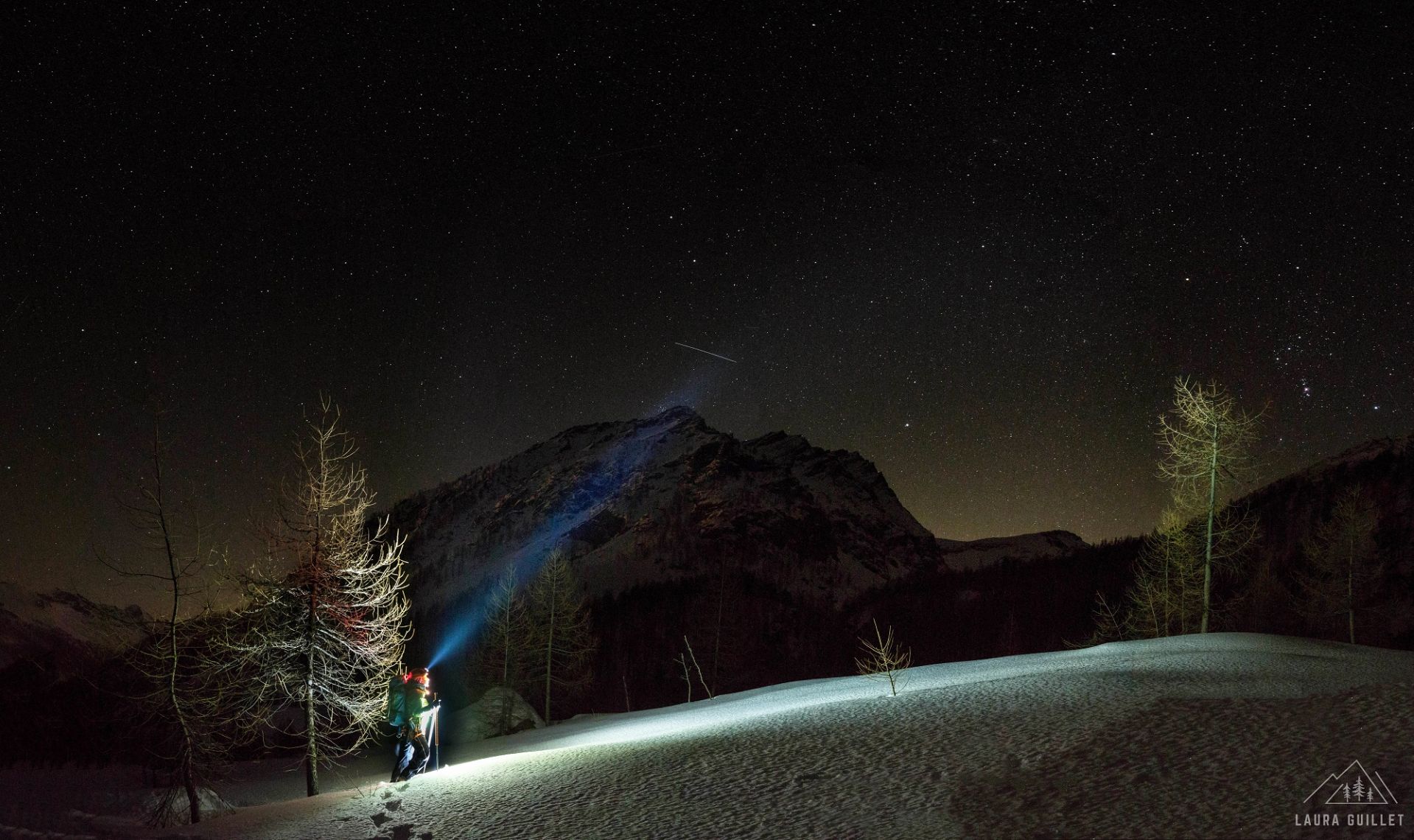
Customer Laura Guillet is a French outdoor photographer based in the Alps. Her passion for the mountains and outdoors made her leave Paris six years ago to be able to be in the mountains as much as possible. She shoots all mountain activities from climbing to backcountry skiing. Laura got in touch to share some of the image of the mountains she loves, and explain the gear set-up she uses to capture these shots:
Words and photos by Laura Guillet

My favorite subject is the special atmosphere that we can experience in the outdoors. The wonderful mood we can feel while sharing a bivy in the mountains, or the kind of poetry provided by the landscapes we are surrounded by.
To capture this, my photographic practice require lightweight but powerful equipment. I shoot on the Olympus mirrorless camera system with Zuiko pro lenses. I love their versatility, their performance even in shooting in low light and their weather resistance.
For me, being able to shoot no matter the temperatures or the weather conditions is essential. I just came back from a backcountry skiing trip in Italy. I spent few days in the Lanzo Valley where wilderness is still untouched, with no chair lifts or touristic buildings.

Skiing is a demanding activity where transporting your gear can be a living hell. I found the perfect combo with the f-stop bags. I use an f-stop Loka UL 37L. Its front pocket is perfect for carrying safety gear (avalanche shovel and probe) and I can attach my skis and tripod on the sides of the bag while I carry an ice tool on the front. The main pocket holds the rest of my daily gear.
I carry my camera, an extra lens and spare batteries in the f-stop Harney pouch, fixed to the Loka UL's shoulder strap’s rings. Thus, my camera is well protected from snow and falls but still accessible going uphill and downhill.
The Loka UL is my favorite pack. I also use it as main summer climbing / mountaineering pack, and as my all-around pack while travelling. When I need to carry more gear for a multidays trip, I use the f-stop Sukha 70L. It allows me to carry all my camera gear and all the multi-days bivy gear but is still manageable while climbing or hiking.



If these mounatin shots inspire you, find more of Laura's work on her web site, Instagram profile, and Facebook Page .
"We Are f-stop" is for all f-stop users to share their stories from the field, from small daily adventures to epic travels. Contact us with your story on Facebook or drop us an email to [email protected] and let us know where your photography takes you and your f-stop pack!
SHOP ALL GEAR MORE WE ARE f-stop


©2022 F-stop
My name is Brandon Neubert.
During his summer breaks from university studies, Brandon lived out of his car and worked in Jackson, Wyoming, where he wandered and photographed the Tetons during his time off. His time spent there became a pivotal experience to his personal style and photographic technique. He pursues realism in his images, seeking to share the moment as it really was, rather than modifying them into surreal works of art. “God’s in charge of the sunrise, I’m just here to capture it,” has become his mantra. His journey through Switzerland inspired him to add videography to his work that he hopes will entertain, uplift, and encourage his viewers to explore the endless beauty this world has to offer.
Words and images by Brandon Neubert

It is at this point that I am presented with the daunting task of summarizing an entire trip within a single blog post. How does a person begin to describe the experiences he had with his brother over the course of two weeks, 130 miles and 30,800 feet of climbing?
My brother and I began planning the trip together not long after I learned about the Haute Route – a rugged and solitary trail stretching and winding from Mont-Blanc Chamonix, France to the Matterhorn in Zermatt, Switzerland. For Christmas, I presented my brother with a copy of the guidebook we would be using during the trip and we got to work. Several months later we experienced the surreal feelings of our trip becoming a reality, as we boarded our flight and began our journey.
My name is Brandon Neubert. To put it simply, I’m a guy who loves to travel and photograph beautiful things along the way. My favorite photography comes in the form of big prints and wide panoramas. Having traveled to Switzerland before, I’m no stranger to its spectacular beauty. Selecting the Swiss Haute Route as our adventure was an easy decision to make and one I do not regret! I wanted to make this trip different and more unique than others I have gone on before. I decided to put in the effort to film our adventure as best I could. The result is this film, “The Haute Route: A Cinematic Journey through the Swiss Alps.” The positive feedback I’ve received and the enjoyment of creating the images and film has encouraged me to do it again.


Our journey was blessed with relatively few challenges. We knew the rain would be an adversary and did our best to prepare for it accordingly. We purchased lightweight raingear and quick-drying clothing for the trip. It did indeed rain, and we were grateful for the gear, plastic bags and other items we brought along with us, and my Loka UL pack and rain shell were integral to staying dry! Fortunately, all my necessary camera equipment is weather sealed (and even waterproof in some cases), and I was unafraid of using it even during the wettest conditions. This was also the longest trek I have ever endeavored to complete, and while I worked to make sure I was physically prepared for the steep ascents, I wasn’t completely ready for the descents. I experienced occasional problems with my IT band, and halfway through I had to rigorously rub it out in the evenings to be ready to endure the next day of hiking. So far as I was diligent and careful, each day was comfortable.
Despite the occasional rainstorm or physical discomfort, our expedition was an absolute joy! Each valley we crossed into presented new opportunities and landscapes to photograph and was uniquely different from the previous. Every day presented a new adventure as we hiked through brilliantly colored meadows, passed families of feeding Ibex, scaled cliffside bolted ladders, and crossed fields of ancient glacial ice. I found myself stopping frequently on the trail to capture every scene from another perspective or with different lighting. These pauses allowed me to take in the scene and really enjoy myself along the trek. The nature of photography creates a slower experience and helps me savor each moment. I had to be careful not to take too long though! It’s easy to get distracted for too long when you still have miles to cover.


My favorite moments of the trek happened in Zermatt. The light was dynamic, and the rising and setting sun transformed the Matterhorn from moment to moment. One evening after a completely overcast day, I was shocked halfway through dinner when I looked out the window at the Matterhorn and saw a surprisingly phenomenal sunset. Abandoning my dessert, I rushed out the door with my equipment and ran as fast as I could to create the image I had composed earlier. The resulting image was, without a doubt, one of the finest of my entire journey. Surprises like this happened frequently, such as capturing the first morning light on an Ibex, having the clouds part over a lake, or discovering a full moon over Mont Blanc.

In the future, I plan on completing more long-distance treks like this one. I am so grateful to have had my brother with me, as we fed off each other’s companionship and enthusiasm for the journey. I learned a lot about filmmaking and on-the-run video work, and learned how to use equipment such as the drone effectively and efficiently. Some of my future treks will include areas of the world such as Tibet, Japan, the African plains, and Patagonia. Thank you for joining this adventure through my work, and I hope you gained an appreciation for the spectacular sights and sounds of Switzerland as much as Idid while completing this project.
Website | Facebook | Youtube | Instagram
"We Are f-stop" is for all f-stop users to share their stories from the field, from small daily adventures to epic travels. Contact us with your story on Facebook or drop us an email to [email protected] and let us know where your photography takes you and your f-stop pack!
SHOP ALL GEAR MORE WE ARE f-stop


©2022 F-stop
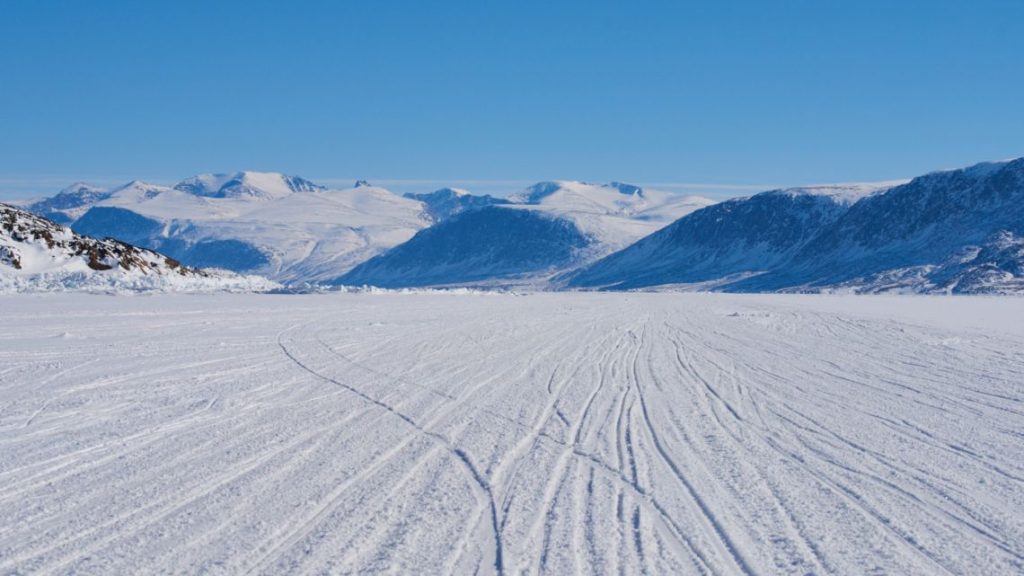
When I was in Nunavut in April 2019 on a project for Destination Nunavut I had an opportunity to go fishing for turbot out on Cumberland Sound, near Pangnirtung, which is just below the entrance to Auyuittuq National Park. Spring had definitely started to arrive in Nunavut. The days were long and the sun was bright. The temperatures, however, were still well below freezing and the ice on Cumberland Sound, a body of water more than a thousand feet deep in places, was still plenty thick for ice fishing.
Words and Images by Jason Nugent

I arrived in the town of Pangnirtung via charter plane from Iqaluit. The flight is just over an hour long and the airport sits right on the edge of the water. Airport formalities are not relevant here. I walked out of the plane, right off the runway, and down to the ice where I met Peter Kilabuk and his crew of fishermen. Peter is from Pangnirtung and knows the area very well. In the past, he worked as a park warden in Auyuittuq National Park. I knew that I was going to have a pretty great day.

"The entrance to Auyuittuq National Park, as seen from Pangnirtung."
Originally, the plan for Pangnirtung involved going into Auyuittuq National Park, the home of Mount Thor and Mount Asgard. If you’ve watched The Spy Who Loved Me, you’ve seen Mount Asgard. The ski jump scene in the intro was filmed on it. Mount Thor, on the other hand, features Earth’s greatest vertical drop, at 4,101 feet. Both have been on my bucket list for a very long time. The problem, however, was that the park is closed right now. There’s simply not enough snow to prevent terrain damage and Parks Canada is doing the right thing by keeping it off limits. Not enough snow in the Arctic Circle? In April? Climate change is a real thing, folks.

"Cozy, isn’t it?"
But, I digress. Back to ice fishing. Crews ice fish all winter long, and the process is a lot of work. We climbed onto snow machines pulling qamutiik, traditional Inuit sleds, and headed out onto Cumberland Sound to a spot some 20 kilometers away. Occasionally we stopped to make sure the ice looked safe for travel.

"Peter spots a seal in the distance."
On one occasion we spotted a seal out in the middle of the sound. We stayed away since seals surface where the ice is thin. When we arrived at the cabin - which was on a sled, so it can be removed at the end of the season - everyone got to work. A hole was broken open and small pieces of Arctic char were cut up to be used as bait.

"The fishing line, baited with Arctic char, lying neatly on the ice to prevent tangling."
More than one hundred hooks were baited on a line that reached all the way to the bottom of the sound, where the turbot were. Slowly, the weighted line was lowered into the hole and adjusted so the current carried it along the bottom. And then the waiting began.
Because this experience wasn’t an overnight one, the plan was to wait about two hours, then haul in the line. Normally, fisherman will wait as long as eight hours, even spending the night in the cabin in temperatures below -40 Celsius. Often, if a line can be set at night, teams will return to Pangnirtung and then return in the morning. Like I said, it’s a lot of work.

"Peter working the winch to retrieve the line."
After two hours, the process of bringing the line back up began. Nowadays it’s done with a small gasoline engine, but it used to be done via hand crank. The line is extremely heavy, especially if there are fish on it. In this case, we ended up with more than 40 turbot. The turbot were cleaned and filleted right there on the ice and packed up to be brought back and sold.
The whole day was an experience I’ll not soon forget. I felt very privileged to have been able to do this. Apparently, it’s not something that visitors to the region usually get to experience. I came away with a better understanding of why First Nations communities feel so connected to the land they share and some knowledge about why it’s so important that we all work together to protect it. I am very much looking forward to going back.

"The fish are cleaned and filleted right after they are caught."
As for gear on this trip, I had my trustyf-stop Tilopa with a Pro ICU - Large, holding two cameras, an assortment of lenses, plus a tripod. The Pro ICU - Large leaves me enough room at the top of the pack for food for the day and a second set of warmer mittens for when I’m not using my camera. I was able to use the side straps to secure a big thermos full of coffee. There’s no point in bringing regular water bottles out in this climate, since they’d freeze solid.

"An Inuk elder looks on."
Jason is an adventure, landscape, and action sports photographer and writer from Eastern Canada. In addition to creating fine art landscape work that is exhibited at galleries in Canada, he travels and writes about his experiences for a number of publications, including Subaru Canada’s Six Star Magazine, Sail Scotland, the Arctic Journal, and others. He is also a member of the Travel Media Association of Canada, a Lumix Storyteller for Panasonic Canada, and ambassador for Altitude Sports, and one of the official photographers for the Canadian Rally Championship.
"We Are f-stop" is for all f-stop users to share their stories from the field, from small daily adventures to epic travels. Contact us with your story on Facebook or drop us an email to [email protected] and let us know where your photography takes you and your f-stop pack!
SHOP ALL GEAR MORE WE ARE f-stop


©2022 F-stop
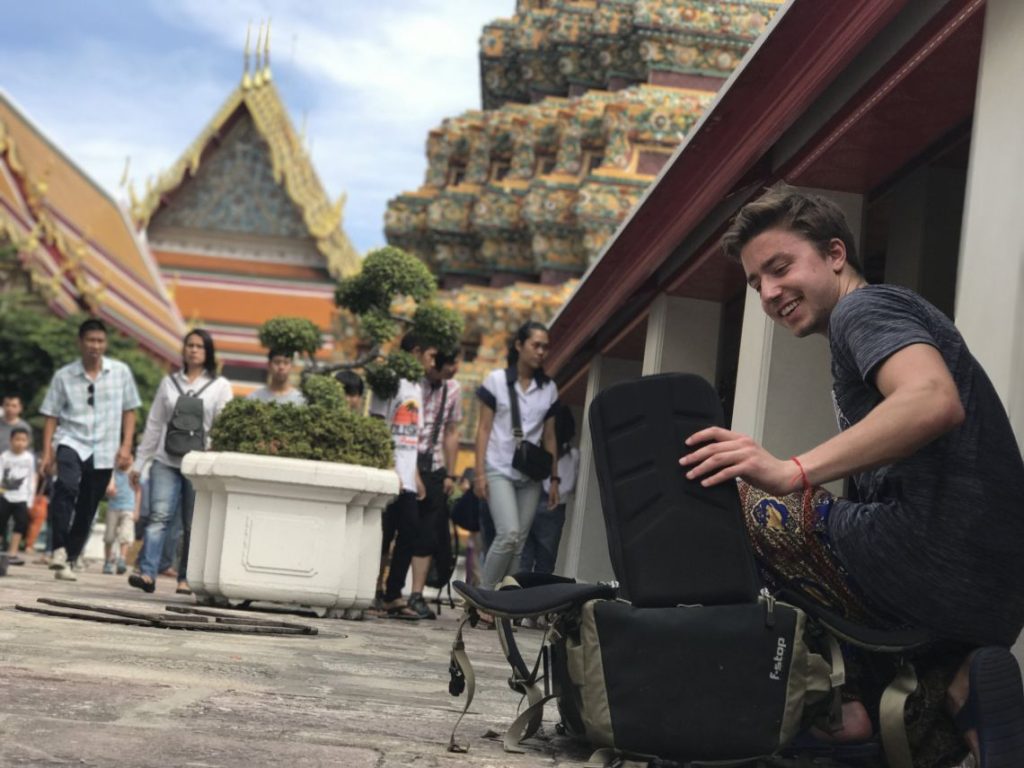
This week's 'We Are f-stop' story comes from Eric Schirtzinger of Madison, Wisconsin-based production company Bascom Brothers. Eric is a visual storyteller, musician, and computer engineer with a fascination for all things creative. Travel has always been at the center of his passion for video production, capturing memories of the worlds wonders as they continue to inspire him. Journey with Eric and his trusty Tilopa through the Thailand, as they spend 25 days capturing the range of experiences, culture and natural beauty they meet on their travels.
Words and photos by Eric Schirtzinger
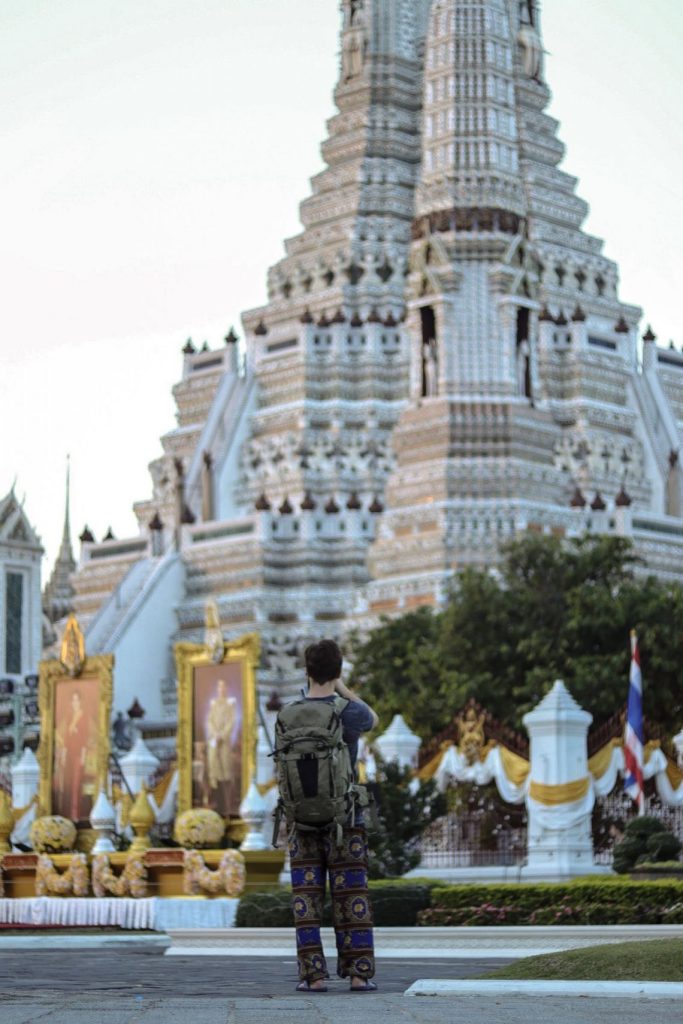
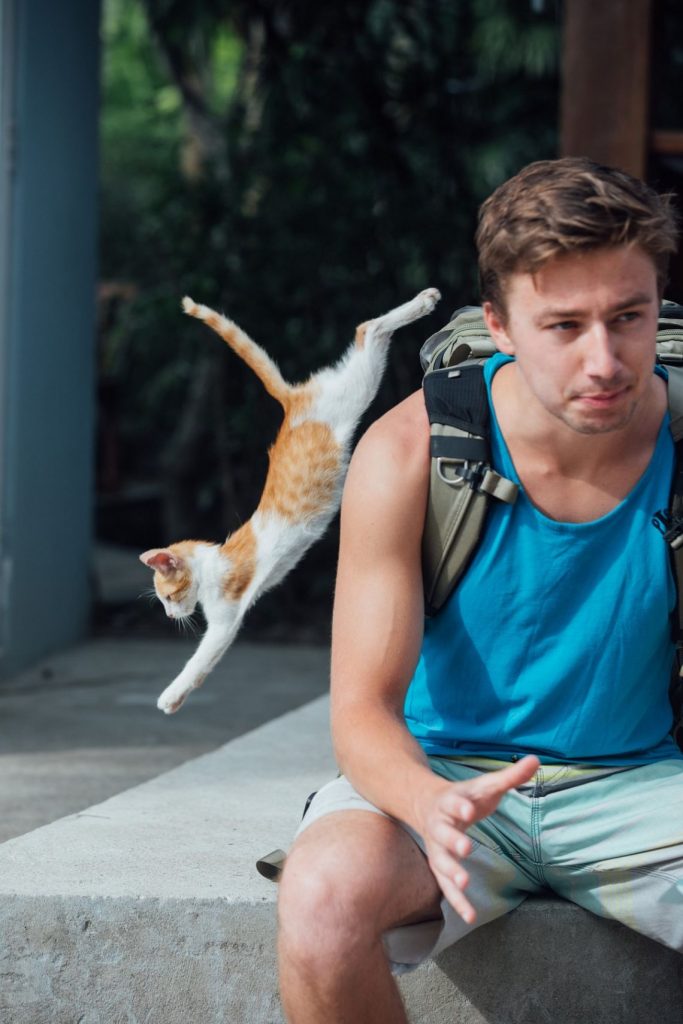
We spent 25 days in Thailand, landing first in Bangkok, where we explored the temples, the city, and were introduced to the Thai culture. We then traveled down to Phuket where we spent our first night all together, in an excessively nice Airbnb. Next, we spent 3 nights in Koh Sok national park, it was here that we had time to relax and reflect on our experiences, talk with the locals, and explore the natural beauty. Following Koh Sok, we spent a night in a hostel in Krabi, then went down to the paradise island of Koh Lanta Yai, kayaking, and mopeding, dodging potholes and cows on the road. Finally we went to Ao Nang, where we spent our days exploring Railay beach, rock climbing it's caves and coastal cliffs.

We made 3 short form edits while on the road, I was able to edit in hostels and airbnbs. On the raod, my Tilopa held my laptop, all my hard drives, and camera gear:
Bangkok (1st stop on the trip). Exploring Buddhist temples, experiencing the night life, the bustle of the city.
Phuket (2nd stop). We left Bangkok and headed to the island of Phuket where we finally met all our friends, staying in this over-the-top airbnb. Monkeys were climbing all over the packs and we had to protect our gear while at "Big Buddha" temple.
Koh Sok (3rd stop, final short edit). A stark contrast to the high end nature of our previous airbnb, we were afloat makeshift cabins on one of the most beautiful lakes we had ever seen. Our tour guides introduced us to Thai culture and we were finally able to experience the nature and culture of Thailand. Storms came through and we got drenched, but it didn't matter, it was paradise.
Bascom Brothers is a Madison Wisconsin based production company, while technically it's only Jacob Holiday and Eric Schirtzinger, they run on a "collective" model where they work very closely with other artists. They have three core artists, Joe Altwies (Photographer @hottcupofjoe), Samuel Li (Photographer/cinematographer @samuelli), and Benjamin Foster (Photographer/storyteller @coldwaterpeople). They have licensed footage and created videos for companies such as Huawei, BIG10 Network, USA today Wisconsin, and Seeker. While most of their videos are corporate or commercial, they try to maintain a freelance culture and enable their employees to work on passion projects. In this beginning stage of their company, they are trying to create the work we want to make, paid or not, so that our brand becomes known for the kind of work they enjoy, the last thing they want is to be stuck making corporate videos forever.
For more of Bascom Brother's work, check their website, Instagram profile, and Facebook page.
Eric Schirtzinger has been creating his whole life; when he was 10 he read program manuals for Macromedia Flash and did 3D modeling in Blender. He is currently studying computer engineering and computer science at University of Wisconsin Madison. He has always ridden the line between "technical" and "artistic" and feels the "left brained" and "right brained" aspects of his personality balance each other out. Travel has always been at the center of his passion for video production, while it's still purely independently funded, capturing memories and some of the worlds wonders continues to inspire him. When he is not traveling, he is filming commercials and promotional content for companies.
See more of Eric's work on his web site, and Instagram profile.
"We Are f-stop" is for all f-stop users to share their stories from the field, from small daily adventures to epic travels. Contact us with your story on Facebook or drop us an email to [email protected] and let us know where your photography takes you and your f-stop pack!
SHOP ALL GEAR MORE WE ARE f-stop


©2022 F-stop
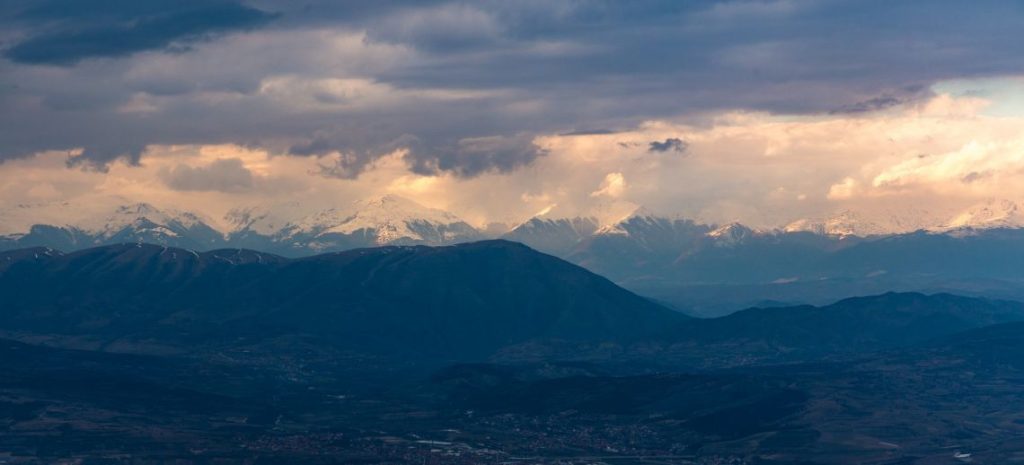
Last Saturday, the f-stop team decided to use the warm weather and spend the day in nature. We met at our offices in Skopje at noon, grabbed some sandwiches, refreshment beverages and headed to the nearest mountain, Vodno. Vodno is the highest mountain located in the center of Skopje Macedonia, with altitude of 1,066 m. Our final destination was the Millennium Cross at the top of the mountain, which was the ideal place for a picnic.
Words and images by the team

The team was excited for the hike, however, since it has been a long winter and long hours at the office, we were quite out of shape and the top of the mountain seemed unreachable. We went through dust, mud and ice but we finally arrived at the top. The view from up there and the feeling that we finally made it, felt really rewarding. The whining eventually ended, and we finally enjoyed the sounds of nature and the fresh air. At the top we found couple of stray dogs that really enjoyed our company, and our sandwiches.


We took the cable car for the way down, so we enjoyed the view and took some photos. Hope we’ll do another hike, once the spring arrives and we get rid of these winter bodies. Until then, let’s enjoy these beautiful photos that we took.
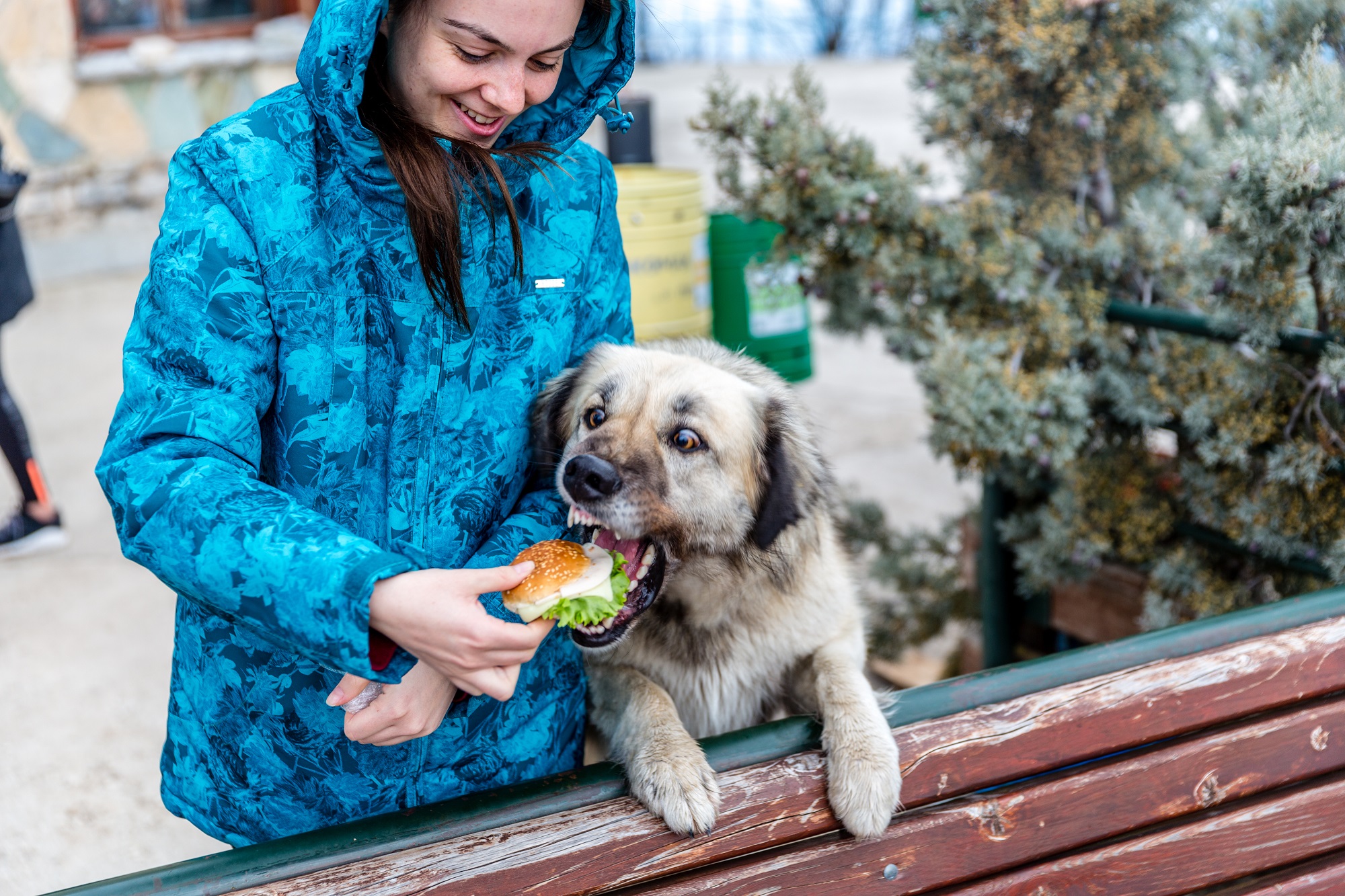
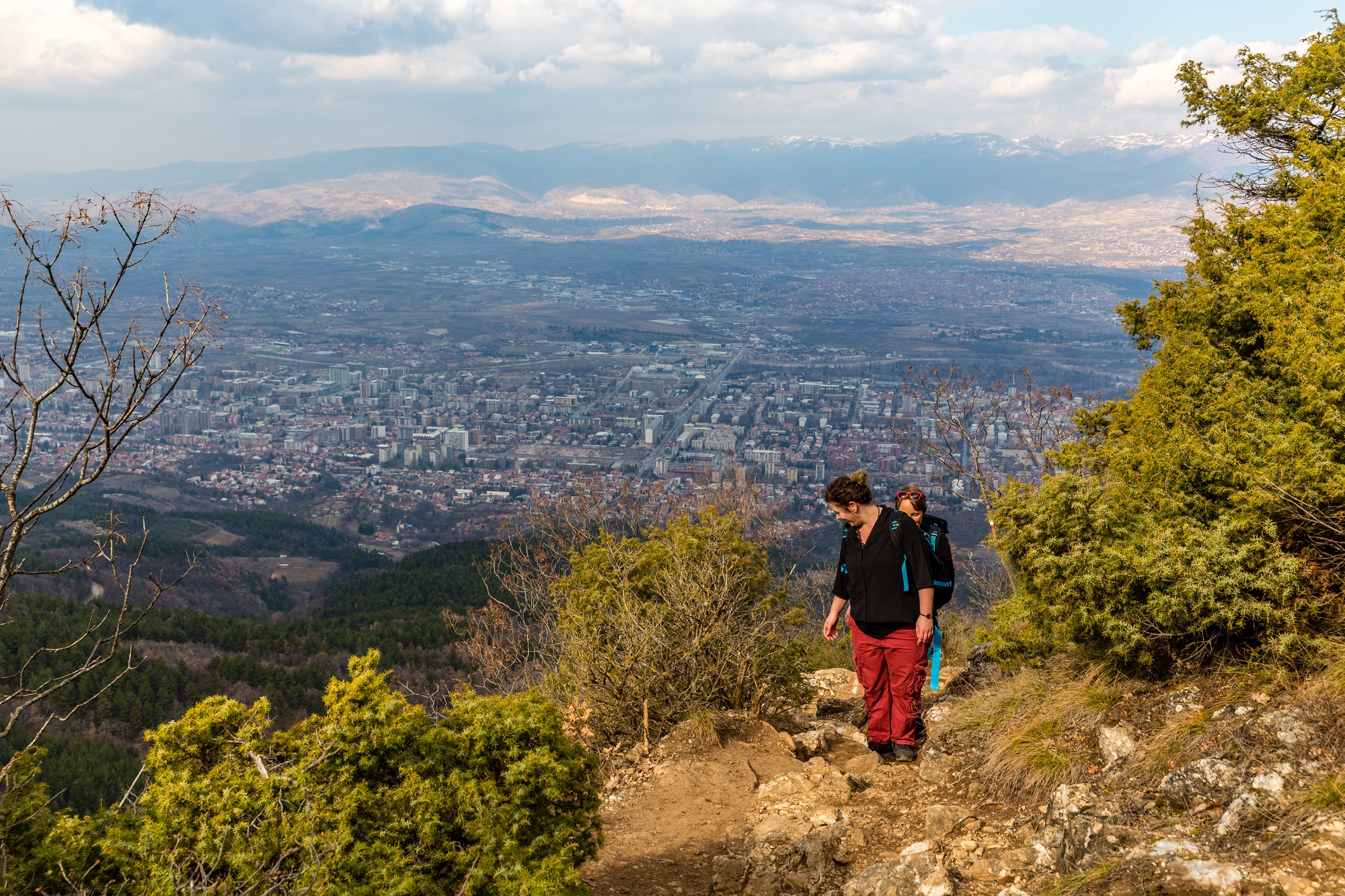
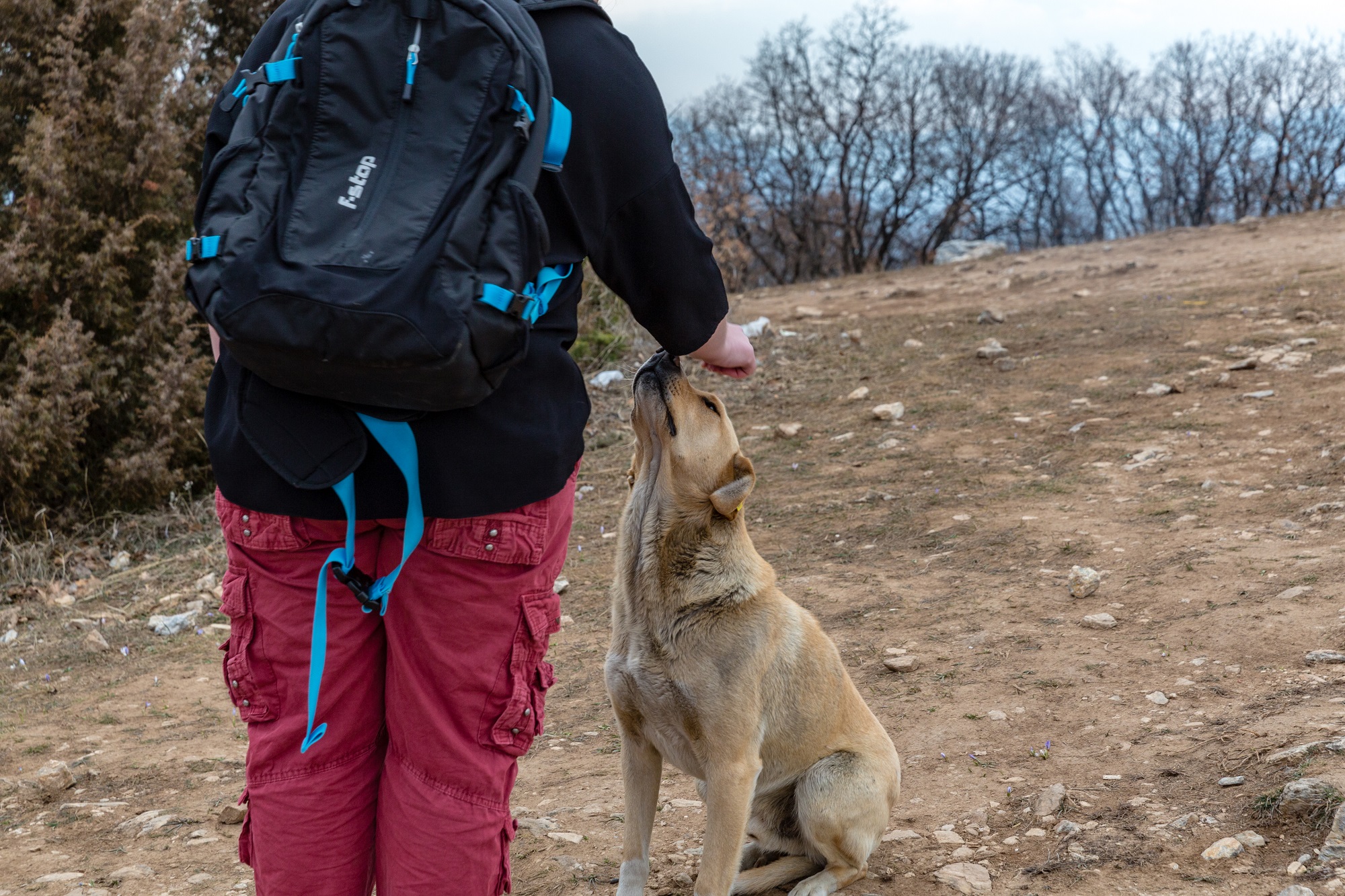
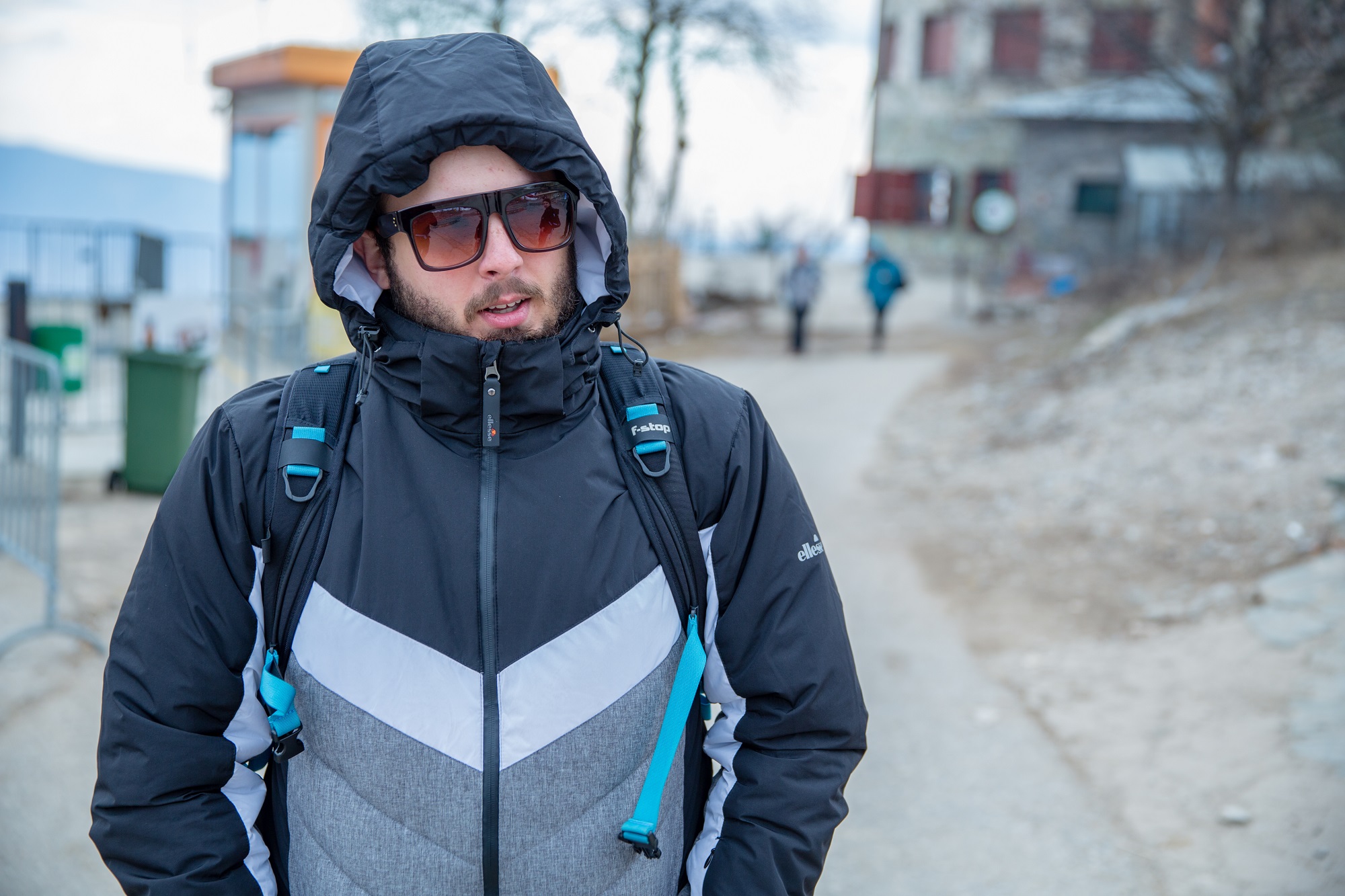

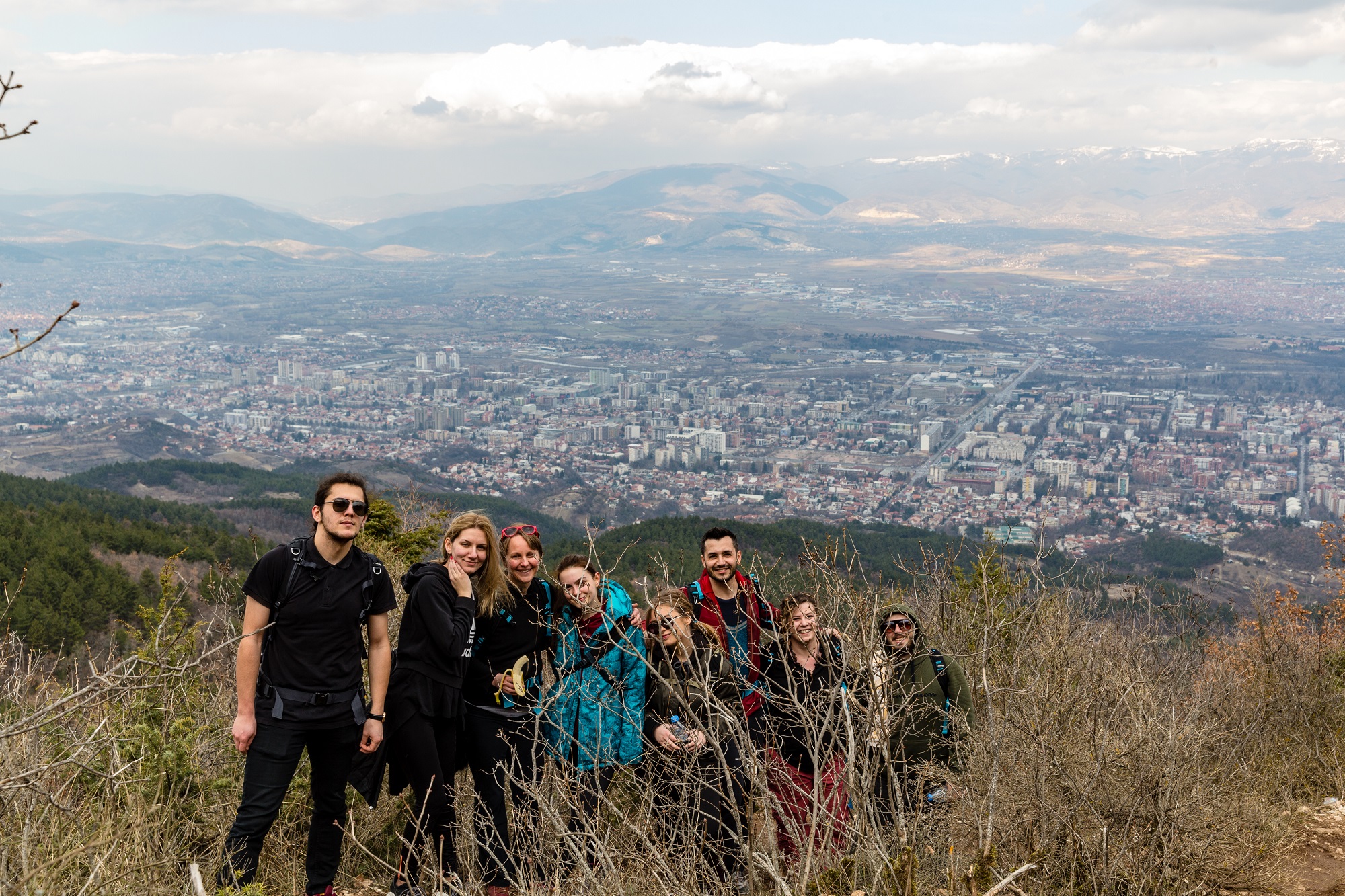
"We Are f-stop" is for all f-stop users to share their stories from the field, from small daily adventures to epic travels. Contact us with your story on Facebook or drop us an email to [email protected] and let us know where your photography takes you and your f-stop pack!
SHOP ALL GEAR MORE WE ARE f-stop


©2022 F-stop


Discount Applied Successfully!
Your savings have been added to the cart.